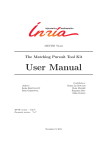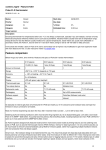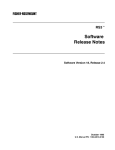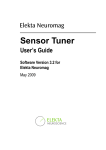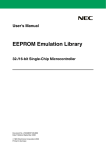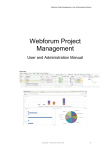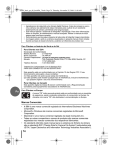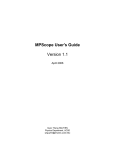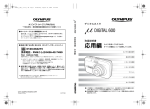Download The Matching Pursuit Tool Kit User Manual and Developer`s
Transcript
The Matching Pursuit Tool Kit
User Manual and Developer’s Notes
Sacha Krstulović and Rémi Gribonval
November 21, 2007, Revision : 1107
Contents
1 General principles
1.1 Terminology . . . . . . . . . . . . . . . . . . . . . . . . . . . . . . . . . . . .
1.2 Algorithm . . . . . . . . . . . . . . . . . . . . . . . . . . . . . . . . . . . . .
2 User manual for the standalone utilities
2.1 Introduction . . . . . . . . . . . . . . . . . . . . . . . . . . . . . .
2.2 the MPTK environment . . . . . . . . . . . . . . . . . . . . . . .
2.3 mpd: signal decomposition . . . . . . . . . . . . . . . . . . . . .
2.4 Format of the dictionary files . . . . . . . . . . . . . . . . . . . .
2.5 mpf: filtering of the book files . . . . . . . . . . . . . . . . . . . .
2.6 mpcat: concatenation of book files . . . . . . . . . . . . . . . . .
2.7 mpr: signal reconstruction . . . . . . . . . . . . . . . . . . . . . .
2.8 mpd demix: blind source separation with a known mixing matrix
2.9 mpview: generation of a time-frequency map from a book . . . .
.
.
.
.
.
.
.
.
.
.
.
.
.
.
.
.
.
.
.
.
.
.
.
.
.
.
.
.
.
.
.
.
.
.
.
.
.
.
.
.
.
.
.
.
.
.
.
.
.
.
.
.
.
.
.
.
.
.
.
.
.
.
.
2
2
3
5
5
6
7
9
17
19
20
21
23
3 The GUI
24
4 Extra utilities: visualization of MP books under Matlab
24
A Development conventions
A.1 Typographic conventions . . . .
A.2 Memory allocation conventions
A.3 Source code locations . . . . . .
A.4 Building and portability . . . .
A.5 Installed files . . . . . . . . . .
.
.
.
.
.
.
.
.
.
.
.
.
.
.
.
.
.
.
.
.
.
.
.
.
.
.
.
.
.
.
.
.
.
.
.
.
.
.
.
.
B Development tricks and notes
B.1 Class interfacing and code factorization . . .
B.2 Speed tricks . . . . . . . . . . . . . . . . . . .
B.3 The parser for XML dictionaries: TinyXML .
B.4 Experimental hacks and limitations – !!READ
C References
.
.
.
.
.
.
.
.
.
.
.
.
.
.
.
.
.
.
.
.
.
.
.
.
.
. . . . .
. . . . .
. . . . .
THIS!!
.
.
.
.
.
.
.
.
.
.
.
.
.
.
.
.
.
.
.
.
.
.
.
.
.
.
.
.
.
.
.
.
.
.
.
.
.
.
.
.
.
.
.
.
.
.
.
.
.
.
.
.
.
.
.
.
.
.
.
.
.
.
.
.
.
.
.
.
.
.
.
.
.
.
.
.
.
.
.
.
.
.
.
.
.
.
.
.
.
.
.
.
.
.
.
.
.
.
.
.
.
.
.
.
.
.
.
.
.
.
.
.
.
25
25
25
25
25
26
.
.
.
.
27
27
27
28
28
29
1
This document aims at describing the basic principles of the Matching Pursuit Tool Kit,
and some basic guidelines about how to use it. The appendix also provides the potential
contributor with notes about the insides of our implementation, plus guidelines about some
of the development conventions that we have adopted. For a more detailed documentation of
the code, see the automatically generated reference manual.
1
General principles
1.1
Terminology
Atom – An elementary piece of signal. An atom is characterized by its class (e.g., Gabor
atoms, harmonic atoms etc.) and a set of parameters (e.g., for a Gabor atom, its time location
and length, its frequency, its amplitude, a chirp factor and a given shaping window). In our
code, the corresponding object knows how to subtract itself from a signal, and how to generate
its own waveform.
Block – A block computes the correlations (inner products) between a signal to analyze
and a set of atoms for which the computation of the correlations can be factorized in an
efficient manner, along the whole support of a signal.
For instance, the inner products can stem from a time-frequency transform, such as the
Fourier Transform or a wavelet transform, provided the transform can be interpreted as a set
of correlations between the signal and a set of atoms which cover the time-frequency plane.
Each block object can search for the location of the maximum correlation between the
atoms and the signal, and can thus deduce which atom contributes the most energy to the
analyzed signal. Several blocks corresponding to various scales or various transforms can
be concurrently applied to the same signal, thus providing for multi-scale or multiple-basis
analysis.
For the moment, the following blocks are implemented:
• Gabor blocks, based on Short-Time Fourier Transforms, which compute the correlations
with windowed sinusoids having a “flat” frequency (chirp rate == 0). In this case, one
block is conceptually equivalent to one STFT with a given scale;
• Harmonic blocks, based on the harmonic grouping of Gabor atoms, and inheriting from
the Gabor block;
• Chirp blocks, based on a post-processing of the Gabor atoms and aimed at optimizing
the chirp rate;
• AnyWave blocks, based on a fast convolution algorithm to compute some correlations
with arbitrary waveforms.
• MDCT/MDST/MCLT blocks. They are transforms based on local cosine functions.
• Dirac blocks,which provide no particular time-frequency transform, but just find the
signal samples which have a high energy
• Constant blocks, which are an extension of the Dirac blocks. Constant atoms are
rectangular windows, defined by a length and a shift between atoms. A constant atom
catches the mean of a signal on the specified frame.
2
• Nyquist blocks. They are defined by a length and a shift between atoms, and the
waveform is a normalized succession of 1 and -1. A Nyquist atom catches the greatest
frequency that can be distinguished (called the Nyquist frequency if the support is even)
of the specified frame.
In the future, blocks based on fast wavelet transforms should also be designed.
Dictionary – A dictionary contains a collection of blocks plus the signal on which they
operate. It can search across all the blocks (i.e., all the scales and all the bases) for the atom
which brings the most energy to the analyzed signal.
Book – A book is a collection of atoms. Summing all the atoms in a book gives a signal.
Figure 1 illustrates the fact that a dictionary contains a signal and a collection of blocks,
and that a books contains a collection of atoms. The algorithm linking these objects will be
explained in the next section.
1.2
Algorithm
Our implementation of the Matching Pursuit algorithm uses roughly 3 steps, as illustrated in
figure 1:
1. update the correlations in the blocks, by applying the relevant correlation computation
algorithm to the analyzed signal, and find the maximum correlation in the same loop;
2. create the atom which corresponds to the maximum correlation with the signal (and
store this atom in the book);
3. subtract the created atom from the analyzed signal, thus obtaining a residual signal,
and re-iterate the analysis on this residual.
At each step, the original signal can be rebuilt exactly by summing all the atoms of the book
and adding them to the residual signal.
3
Dictionary
Book
Block N
Block i
Blocks
2
Atoms
maximum correlation
Block 1
Sc
al
eo
rt
ra
ns
fo
rm
Frequency
1
Time
+=
1
1
0.8
0.8
Analyzed
signal
0.6
0.4
0.2
0
−0.2
−0.4
−0.6
−0.8
−1
0
0.2
0.4
0.6
0.8
−=
1
1.2
1.4
1.6
1.8
2
4
x 10
(Residual)
0.6
0.4
0.2
0
−0.2
−0.4
−0.6
−0.8
−1
0
0.2
0.4
0.6
0.8
1
1.2
1.4
1.6
1.8
2
4
x 10
Rebuilt signal
(Approximant)
3
Figure 1: Our implementation of Matching Pursuit. (See sections 1.1 and 1.2 for a detailed
explanation.)
4
2
User manual for the standalone utilities
2.1
Introduction
The Matching Pursuit standalone utilities are designed so that a typical processing task
decomposes into a chain of commands which can be connected by pipes. The signal decomposition is performed by mpd. The atoms stored in the resulting books can be filtered (i.e.,
sorted and selected) with the command mpf. Several books can then be concatenated with
the command mpcat. Once a desired book is obtained, a corresponding approximant signal
can be rebuilt using mpr, with the optional addition of a residual signal (or in addition to
any other signal). Alternately, the mpd demix utility provides blind source separation using
Matching Pursuit when the mixing matrix is known. Each of the cited utilities have a -h
switch to get command-line help.
Some typical processing chains include:
• Signal approximation with N atoms:
mpd -D dictionary -n N soundFile.wav book.bin;
mpr book.bin approx.wav
– or –
mpd -D dictionary -n N soundFile.wav - | mpr - approx.wav
• Exact reconstruction:
mpd -D dictionary -n N soundFile.wav book.bin residual.wav;
mpr book.bin approx.wav residual.wav
• Signal approximation, using only the short atoms (e.g., of less than 128 samples)
and ignoring the residual:
mpd -D dictionary -n N soundFile.wav book.bin;
mpf --length=[0:128] book.bin bookShort.bin;
mpr bookShort.bin approx.wav
• Blind source separation and rebuilding an approximation of one of the sources (e.g.,
the 3rd one):
mpd demix -D dictionary -M matrix.txt -n N mix.wav bookFile;
mpr bookFile 3.bin approxOfSource3.wav
Lots of other combinations are possible. The relevant utilities are described with more detail
in the next sections.
Note about the signal file formats – MPTK has been originally designed for sound
processing, but it is applicable to any kind of signal.
For input, we have mostly been using the WAV format, but any file format recognized by
the libsndfile library (i.e., most audio formats, see http://www.mega-nerd.com/libsndfile/)
should work with the provided MPTK utilities.
The signal output is more specific: the MPTK binaries output signals in the WAV format
only. (WARNING: in the libsndfile implementation, this format is not protected against
clipping, which may happen for some books and is not an artifact of the MPTK analysis.)
Nevertheless, the MPTK API also offers Matlab, raw double and raw float signal output
formats: those could be quickly enabled by simple hacks of the relevant utilities. To enable
other output formats, please contribute some code to the mp_signal.{h,cpp} API.
5
2.2
the MPTK environment
In order to define the working environment of Matching Pursuit utilities, An XML file is loaded
before using Matching Pursuit. This XML file contains the configuration path <configpath>
path</configpath> the syntax of the path is <path name="NAME" path="PATH"/> the path
used are:
• dll_directory the directory where MPTK library search for plugins Dynamic Link
Library (DLL) defining atoms and blocks
• fftw_wisdomfile the default path for the FFTW wisdom file which allows to save the
setting for FFT computation.
This values can be set by two way, the complete path of the file can be specified with
the -C<FILE>, -config-file=<FILE> for utilities or MPTK library calls the environment
variable MPTK_CONFIG_FILENAME to determine which file to use for setting up the MPTK
environment.
6
2.3
mpd: signal decomposition
Usage:
mpd [options] -D dictFILE.txt (-n N|-s SNR) (sndFILE.wav|-) (bookFILE.bin|-) ...
... [residualFILE.wav]
Synopsis:
Iterates Matching Pursuit on signal sndFILE.wav with dictionary dictFILE.txt and gives the
resulting book bookFILE.bin (and an optional residual signal) after N iterations or after
reaching the signal-to-residual ratio SNR. See section 2.4 for a description of the syntax of
the dictionary files.
Mandatory arguments:
-D<FILE>, --dictionary=<FILE> Read the dictionary from text file FILE.
-n<N>, --num-iter=<N>|--num-atoms=<N>
AND/OR -s<SNR>, --snr=<SNR>
(sndFILE.wav|-)
Stop after N iterations.
Stop when the SNR value SNR
is reached. If both options are
used together, the algorithm stops
as soon as either one is reached.
The signal to analyze or stdin
(in WAV format).
The file to store the resulting
book of atoms, or stdout.
(bookFILE.bin|-)
Optional arguments:
-C<FILE>, -config-file=<FILE> Use the specified configuration file,
otherwise the MPTK_CONFIG_FILENAME environment
variable will be used to find the configuration
file and set up the MPTK environment
-E<FILE>, --energy-decay=<FILE> Save the energy decay as doubles
to file FILE.
-R<N>,
--report-hit=<N>
Report some progress info (in stderr)
every N iterations.
-S<N>,
--save-hit=<N>
Save the output files every N iterations.
-T<N>,
--snr-hit=<N>
Test the SNR every N iterations only
(instead of each iteration).
-p<double>, --preemp=<double>
residualFILE.wav
Pre-emphasize the input signal with
coefficient <double>.
The residual signal after subtraction
of the atoms.
7
-q,
-v,
-V,
-h,
--quiet
--verbose
--version
--help
No text output.
Verbose.
Output the version and exit.
This help.
8
2.4
Format of the dictionary files
The dictionary files use a XML syntax, with tags enclosed between angle brackets. Strict
XML compliance is now mandatory. 1 .
General rules
A dictionary should include, in the following order:
1. an optional XML declaration line;
2. a mandatory dictionary opening tag;
3. an optional library version tag;
4. a list of blocks with their parameters (some parameters being mandatory, some admitting default values);
5. a dictionary closing tag.
Any text included after the dictionary closing tag will be ignored. Blank spaces and line
breaks are ignored. Any part of the file can be commented out either by enclosing it between
<!-- and --> (XML style) The parser will send any text it can’t match to stderr with a error
message: in the event of syntax errors in a dictionary, some dictionary pieces will therefore
show up in stderr.
Valid tags
• <?xml version="1.0" encoding="ISO-8859-1"?> [optional]: the XML declaration
line.
• <dict>List of blocks</dict>: the opening and closing tags for the dictionary. Anything
coming after the </dict> tag will be ignored by the parser.
• <libVersion>blah</libVersion> [optional]: the library version declaration. This is
provided for backward compatibility if we ever change the dictionary syntax. When
absent, the library version is taken to be the current one.
• <blockproperties name="PROPERTIES_NAME">List of block parameters</blockproperties>:
the opening and closing tags for a block properties list.this
• <block uses="PROPERTIES_NAME">List of block parameters</block>: the opening and
closing tags for a block. The block will be construct using the list of parameters defined
in PROPERTIES_NAME block properties.
• <block>List of block parameters</block>: the opening and closing tags for a block.
the list of block parameters should contains all the mandatories parameters for this type
of block
1
Uh, that is, if a DTD get ready someday.
9
• <par type="NAME" value="VALUE"/> : a block parameter. The NAME and corresponding VALUE value in string. The parameter value is set to the corresponding type when
the dictionary file is parsed.
Note that when using the <block uses="PROPERTIES_NAME">List of block parameters
</block> syntax. The block parameters defined in the block list override the parameters
from PROPERTIES_NAME block properties.
The list of parameters for relevant block types (G==gabor, H==harmonic, C==Chirp,
A==Anywave, CT==constant, N==nyquist) are given below:
– (G,H,C,CT,N) windowLen with an unsigned long int value: the atom length (i.e.,
the window length in the STFT).
– (G,H,C,A,CT,N) windowShift with an unsigned long int value: the atom shift
(i.e., the window shift in the STFT).
– (G,H,C) windowRate with a double value between 0.0 and 1.0: an alternate way to
specify the window shift, as a proportion of the windowLen. If both are present,
windowShift has precedence over windowRate.
– (G,H,C) fftSize with an unsigned long value: the frequency resolution in terms
of FFT size. It has to be greater or equal to windowLen if windowLen is even,
or ≥(windowLen+1) if windowLen is odd. If absent, defaults to windowLen (or
windowLen+1).
– (G,H,C,CT,N) blockOffset with an unsigned long value: the block Offset, i.e.
the position of the first frame. If absent, defaults to 0.
– (G,H,C,CT,N) windowtype the window specification to be included among the
block parameters.
– (G,H,C,CT,N) windowopt the optional parameter for window type:
∗ The following windowtypes do not require the windowopt attribute:
rectangle, triangle, cosine, hanning, hamming, blackman, flattop, fof.
∗ The following windowtypes do require the windowopt attribute:
hamgen, gauss, exponential.
The meaning of the optional parameter varies according to the window type.
See the reference manual for more info.
– (H) f0Min with a double value: minimum frequency (in Hz) from which the fundamental frequency of the harmonic atoms is searched. Defaults to the first non-null
FFT frequency.
– (H) f0Max with a double value: maximum frequency (in Hz) at which the fundamental frequency of the harmonic atoms is searched. Defaults to the Nyquist
frequency of the considered signal.
– (H) numPartials with an unsigned int value: number of partials considered when
tracking the harmonic atoms.
– (C) numFitPoints (EXPERIMENTAL) with an unsigned int value: number of
polynomial fitting points considered for the chirp optimization algorithm. Defaults
to 1.
– (C) numIter (EXPERIMENTAL) with an unsigned int value: number of iterations
considered for the chirp optimization algorithm. Defaults to 1.
10
– (A) tableFileName with a string: filename of the table containing the waveforms
(ex: —/udd/toto/table.bin— ). Note that there is no ” around the string.
Note that the dirac blocks don’t need any parameter (they just match signal samples).
Example
<?xml version="1.0" encoding="ISO-8859-1"?>
<dict>
<libVersion>0.2</libVersion>
<= The optional XML
declaration line.
<= The dictionary opening tag.
<= The optional library version.
<blockproperties name="GAUSS-WINDOW">
<= A new block properties.
<param name="windowtype" value="gauss"/>
<param name="windowopt" value="0.02"/> <= Gauss windows need
a parameter.
</blockproperties>
<blockproperties name="HAMMING-WINDOW">
<= Another block properties.
<param name="windowtype" value="hamming"/>
<param name="windowopt" value="0"/> <= The hamming window
ignores the opt="0"
attribute.
</blockproperties>
<block uses="GAUSS-WINDOW">
<param
<param
<param
<param
</block>
<= A new block using
GAUSS-WINDOW block properties.
name="type" value="gabor"/>
name="windowLen" value="32"/>
name="windowShift" value="32"/>
name="fftSize" value="32"/>
<blockproperties name="GAUSS-WINDOW-BIS" refines="GAUSS-WINDOW">
<param name="windowopt" value="0.02"/> <= A new block properties overriding
the GAUSS-WINDOW block properties.
</blockproperties>
<block uses="GAUSS-WINDOW-BIS">
<= A new block using
GAUSS-WINDOW-BIS block properties.
<param name="type" value="gabor"/>
<param name="windowLen" value="32"/>
<param name="windowRate" value="0.25"/>
<= This is equivalent to
setting windowShift=16.
<param name="fftSize" value="64"/>
</block>
<blockproperties name="WINDOW-SHIFT">
<= A new block properties.
<param name="windowShift" value="32"/> <= A value for the
11
window shift.
</blockproperties>
<!--
<block uses="WINDOW-SHIFT">
<param name="windowLen" value="128"/>
<param name="windowShift" value="32"/>
<param name="fftSize" value="128"/>
-->
</block>
<block uses="GAUSS-WINDOW">
<param name="type" value="gabor"/>
<varparam name="fftSize">
<var>64</var>
<var>32</var>
<var>16</var>
<var>8</var>
</varparam>
<param name="windowLen" value="8"/>
<varparam name="windowShift">
<var>64</var>
<var>32</var>
<var>16</var>
</varparam>
</block>
<block uses="GAUSS-WINDOW-BIS">
<param name="type" value="harmonic"/>
<param name="fftSize" value="256"/>
<param name="windowLen" value="256"/>
<param name="windowShift" value="128"/>
<param name="f0Min" value="340"/>
<param name="f0Max" value="1000"/>
<param name="numPartials" value="5"/>
</block>
<block uses="GAUSS-WINDOW">
<param name="type" value="chirp"/>
<param name="fftSize" value="1024"/>
<param name="windowLen" value="1024"/>
<param name="windowShift" value="128"/>
<param name="numFitPoints" value="2"/>
<param name="numIter" value="1"/>
</block>
<block>
<param name="type" value="anywave"/>
12
<= These lines are
commented out.
This block will use
the default
windowShift from
WINDOW-SHIFT, and will default
fftSize to windowLen.
<= A variable parameter list.
a list of block for each value
of the variable parameter list.
<= Another variable parameter list.
a list of block for each value
of the variable parameter list,
combined with the list of block
defined above.
<= A harmonic block.
<= A chirp block.
<= An anywave block.
<param
<param
</block>
<block>
<param
</block>
<block>
<param
<param
<param
</block>
<block>
<param
<param
<param
</block>
name="tableFileName" value="/udd/toto/table.xml"/>
name="windowShift" value="1"/>
name="type" value="dirac"/>
<= A dirac block.
name="type" value="constant"/>
name="windowLen" value="512"/>
name="windowShift" value="32"/>
<= A constant block.
name="type" value="nyquist"/>
name="windowLen" value="512"/>
name="windowShift" value="32"/>
</dict>
This is that great dictionary I used for obtaining
these wonderful experimental results thanks to the
Matching Pursuit Library ...
<= A nyquist block.
<= This text is ignored
by the parser.
Anywave table
Waveforms need have been loaded before using anywave atoms. That’s the difference between
parametric atoms, such as Dirac, Gabor, ... and anywave atoms. Therefore, a different syntax
has to be employed. In the dictionary file, the anywave block points to a “anywave table
definition file” (/udd/toto/table.bin in the example). This file has a XML syntax, to give all
the parameters of the waveforms, and points to a binary “anywave table data file”, that gives
the data (/udd/toto/table data.bin in the example).
Note that one table corresponds to one atom length, and one number of channels. To use
several atom lengths, one must create several anywave tables, and define several “anywave”
blocks.
The “anywave table definition file” is structured as follows:
• <?xml version="1.0" encoding="ISO-8859-1"?> [optional]: the XML declaration
line. It is ignored by the parser.
• <table>List of table parameters</table>: the opening and closing tags for the table.
Anything coming after the </table> tag will be ignored by the parser.
• <libVersion>blah</libVersion> [optional]: the library version declaration. This is
provided for backward compatibility if we ever change the dictionary syntax. When
absent, the library version is taken to be the current one.
• <par type="NAME" value="VALUE"/> : a table parameter. The NAME and corresponding VALUE value in string. The parameter value is set to the corresponding type when
the table parameter file is parsed. The NAME and corresponding VALUEs types are given
below:
13
– numChans with an unsigned short int value: the number of channels of the atoms.
– filterLen with an unsigned long int value: the length of the anywave waveforms
in the table.
– numFilters with an unsigned long int value: the number of anywave waveforms
in the table.
– data with a string: name of the file containing the waveforms data (ex: —
/udd/toto/table data.bin— ). Note that there is no ” around the string.
The “anywave table data file” is binary, and built as follows: all the waveforms are written
in double type, one after the other, and for each, one channel after the other. The following
scheme is for two channels and four waveforms:
—w1c1—w1c2—w2c1—w2c2—w3c1—w3c2—w4c1—w4c2—
Example of an anywave table
<?xml version="1.0" encoding="ISO-8859-1"?>
<table>
<= The optional XML
declaration line.
<= The table opening tag
(only one table per file
<= The optional library version.
<libVersion>0.4beta</libVersion>
<param name="numChans" value="1"/>
<param name="filterLen" value="64"/>
<param name="numFilters" value="20"/>
<param name="data" value="/udd/toto/table_data_001.bin"/>
</table>
<= The table closing tag.
MDCT/MDST/MCLT
Definition The Modified Discrete Cosine Transform (MDCT) and the Modified Discrete
Sine Transform (MDST) are two orthogonal transforms based on local cosine functions. The
Modulated Complex Lapped Transform (MCLT) is the complex extension such as M CLT =
M DCT + i ∗ M DST . The atoms corresponding to the MCLT of a signal of length N = P L
and a window length of 2L, are defined as:
1 L
1
π
(n − pL) + +
k+
(1)
xp,k (n) = w(n − pL)exp i
L
2
2
2
with n = 0, .., N −1, k = 0, .., L−1 and p = 0, .., P −1. w is a window which is complementary
in energy i.e. it verifies w2 (n) + w2 (n + L) = 1, n = 0, .., L − 1.
The atoms corresponding to the MDCT are defined as the real part of the previous formula
and the atoms corresponding to the MDST the imaginary part of the previous formula.
We also define a generalized MDCT/MDST/MCLT where the window shift, the window
shape and the fft size are not constraint by the orthogonality property. The corresponding
atoms for a signal of length N = P S, a window length of 2L, a window shift of S, a fft size
of N f f t and a window w, are defined as:
1 L
1
2π
(n − pS) + +
k+
if N f f t = 2L
(2)
xp,k (n) = w(n − pS)exp i
Nfft
2
2
2
1 L
2π
(n − pS) + +
(k) if N f f t = 2mL
(3)
xp,k (n) = w(n − pS)exp i
Nfft
2
2
14
with n = 0, .., N − 1, k = 0, .., N f f t/2 − 1, p = 0, .., P − 1 and m is even with m >= 2.
Valid tags
• <?xml version="1.0" encoding="ISO-8859-1"?> [optional]: the XML declaration
line. It is ignored by the parser.
• <libVersion>blah</libVersion> [optional]: the library version declaration. This is
provided for backward compatibility if we ever change the dictionary syntax. When
absent, the library version is taken to be the current one.
• <dict>List of blocks</dict>: the opening and closing tags for the dictionary. Anything
coming after the </dict> tag will be ignored by the parser.
The list of parameters for relevant block types (G==gabor, H==harmonic, C==Chirp,
A==Anywave, CT==constant, N==nyquist) are given below:
– windowLen with an unsigned long int value: the atom length (i.e., the window
length). It has to be even.
– windowShift with an unsigned long int value: the atom shift (i.e., the window
shift).
– windowRate with a double value between 0.0 and 1.0: an alternate way to specify the window shift, as a proportion of the windowLen. If both are present,
windowShift has precedence over windowRate.
– fftSize with an unsigned long value: the frequency resolution in terms of FFT
size. It has to be equal to windowLen or a multiple of 2*windowLen.
– blockOffset with an unsigned long value: the block Offset, i.e. the position of
the first frame. If absent, defaults to 0.
– windowtype the window specification to be included among the block parameters.
– windowopt the optional parameter for window type:
∗ The following windowtypes do not require the opt="" attribute:
rectangle, triangle, cosine, hanning, hamming, blackman, flattop, fof.
∗ The following windowtypes do require the opt="" attribute:
hamgen, gauss, exponential, kbd.
The meaning of the optional parameter varies according to the window type.
See the reference manual for more info.
A default MDCT/MDST/MCLT block is defined using 2 parameters, the window length
and the window type. The window type must be rectangle, cosine or kbd. An example of
a MDCT dictionnary is:
<?xml version="1.0" encoding="ISO-8859-1"?>
<dict>
<libVersion>0.2</libVersion>
<block>
<param name="type" value="mdct"/>
<param name="windowLen" value="2048"/>
<param name="windowtype" value="kbd"/>
15
<param name="windowopt" value="5"/>
</block>
</dict>
An example of a generalized MCLT dictionnary is:
<?xml version="1.0" encoding="ISO-8859-1"?>
<dict>
<libVersion>0.2</libVersion>
<block>
<param name="type" value="mdct"/>
<param name="windowLen" value="2048"/>
<param name="fftSize" value="4096"/>
<param name="windowtype" value="cosine"/>
<param name="windowopt" value="0"/>
</block>
</dict>
16
2.5
mpf: filtering of the book files
Usage:
mpf --PROPERTY1=[min:max] ... --PROPERTY_N=[min:max] (bookIn.bin|-) ...
[bookYes.bin|-] [bookNo.bin]
Synopsis:
Filters the atoms contained in bookIn.bin (or stdin), stores those which satisfy the indicated
properties in bookYes.bin (or stdout) and the others in bookNo.bin.
Mandatory arguments:
(bookIn.bin|-)
A book of input atoms, or stdin.
Optional arguments:
(bookYes.bin|-)
A file (or stdout) to store the book of atoms which
satisfy the indicates properties.
bookNo.bin
A file to store a book of atoms which do not satisfy
the indicated properties.
If no output files are given, the atoms are just counted and their number
is reported in stderr.
One or more of the following switches:
--index=[min:max]
/ -i [min:max] : keep the atoms ordered from min to max
in the book
--length=[min:max]
/ -l [min:max] : keep a specific range of atom lengths
(in number of samples)
--Length=[min:max]
/ -L [min:max] : keep a specific range of atom lengths
(in seconds)
--position=[min:max] / -p [min:max] : keep a specific range of atom positions
(in number of samples)
--Position=[min:max] / -P [min:max] : keep a specific range of atom positions
(in seconds)
--freq=[min:max]
/ -f [min:max] : keep a specific frequency range (in
normalized values between 0 and 0.5)
--Freq=[min:max]
/ -F [min:max] : keep a specific frequency range (in Hz)
--amp=[min:max]
/ -a [min:max] : keep a specific range of amplitudes
--chirp=[min:max]
/ -c [min:max] : keep a specific range of chirp factors
The intervals can exclude the min or max value by using reverted braces,
e.g. ]min:max] will exclude the min value.
The intervals can be negated with prepending the ’^’ character,
e.g. ^[min:max].
The atom’s type can be tested with:
17
--type=gabor|harmonic|dirac|anywave / -t gabor|harmonic|dirac|anywave
(The chirp type is not provided: a chirp atom is a gabor atom with
a non-null chirp rate.)
Other optional arguments are:
-C<FILE>, -config-file=<FILE> Use the specified configuration file,
otherwise the MPTK_CONFIG_FILENAME environment
variable will be used to find the configuration
file and set up the MPTK environment
-q, --quiet
No text output.
-v, --verbose
Verbose.
-V, --version
Output the version and exit.
-h, --help
This help.
Example:
Take all the atoms with a frequency lower than 50Hz and higher than 1000Hz among the first
100 atoms of bookIn.bin, store them in bookYes.bin and store all the others in bookNo.bin:
mpf --index=[0:100[ --Freq=^[50:1000] bookIn.bin bookYes.bin bookNo.bin
Note:
Only one instance of each property is allowed. More complicated domains can be elaborated
using pipes.
18
2.6
mpcat: concatenation of book files
Usage:
mpcat (book1.bin|-) (book2.bin|-) ... (bookN.bin|-) (bookOut.bin|-)
Synopsis:
Concatenates the N books book1.bin...bookN.bin into the book file bookOut.bin.
Mandatory arguments:
(bookN.bin|-)
(bookOut.bin|-)
At least 2 books (or stdin) to concatenate.
A book where to store the concatenated books,
or stdout
Optional arguments:
-C<FILE>, -config-file=<FILE> Use the specified configuration file,
otherwise the MPTK_CONFIG_FILENAME environment
variable will be used to find the configuration
file and set up the MPTK environment.
-f, --force
Force the overwriting of bookOut.bin.
-q,
-v,
-V,
-h,
--quiet
--verbose
--version
--help
No text output.
Verbose.
Output the version and exit.
This help.
19
2.7
mpr: signal reconstruction
Usage:
mpr (bookFILE.bin|-) (reconsFILE.wav|-) [residualFILE.wav]
Synopsis:
Rebuilds a signal reconsFile.wav from the atoms contained in the book file bookFile.bin. An
optional residual can be added.
Mandatory arguments:
(bookFILE.bin|-)
(reconsFILE.wav|-)
A book of atoms, or stdin.
A file to store the rebuilt signal, or stdout
(in WAV format).
Optional arguments:
-C<FILE>, -config-file=<FILE> Use the specified configuration file,
otherwise the MPTK_CONFIG_FILENAME environment
variable will be used to find the configuration
file and set up the MPTK environment.
residualFILE.wav
A residual signal that was obtained from
a Matching Pursuit decomposition.
-q,
-v,
-V,
-h,
--quiet
--verbose
--version
--help
No text output.
Verbose.
Output the version and exit.
This help.
20
2.8
mpd demix: blind source separation with a known mixing matrix
Usage:
mpd_demix [options] -D dictFILE.txt -M matrix.txt (-n N|-s SNR) ...
(sndFILE.wav|-) (bookFILE) [residualFILE.wav]
Synopsis:
Performs Blind Source Separation on signal sndFILE.wav with dictionary dictFile.txt and
with the known mixer matrix mixFILE.txt. The result is stored in as many books as estimated
sources (plus an optional residual signal), after N iterations or after reaching the signal-toresidual ratio SNR.
Mandatory arguments:
-M<FILE>, --mix-matrix=<FILE> Read the mixer matrix from text file FILE.
The first line of the file should indicate
the number of rows and the number of columns,
and the following lines should give space
separated values, with a line break after
each row.
EXAMPLE:
2 3
0.92 0.38 0.71
0.71 0.77 1.85
-n<N>, --num-iter=<N>|--num-atoms=<N>
AND/OR -s<SNR>, --snr=<SNR>
(sndFILE.wav|-)
Stop after N iterations.
Stop when the SNR value SNR
is reached.
If both options are used together,
the algorithm stops as soon as
either one is reached.
The signal to analyze or stdin
(in WAV format).
The base name of the files to store
the books of atoms_n corresponding
to the N estimated sources. These
N books will be named bookFILE_n.bin,
n=[0,...,N-1].
(bookFILE)
Optional arguments:
-C<FILE>, -config-file=<FILE>
Use the specified configuration file,
otherwise the MPTK_CONFIG_FILENAME environment
variable will be used to find the configuration
21
file and set up the MPTK environment.
Read the dictionary from text file FILE.
If no dictionary is given, a default
dictionary is used.
(Use -v to see the structure of the default
dictionary reported in the verbose information.)
-E<FILE>, --energy-decay=<FILE> Save the energy decay as doubles to file FILE.
-Q<FILE>, --src-sequence=<FILE> Save the source sequence as unsigned short ints
to file FILE.
-R<N>,
--report-hit=<N>
Report some progress info (in stderr) every
N iterations.
-S<N>,
--save-hit=<N>
Save the output files every N iterations.
-T<N>,
--snr-hit=<N>
Test the SNR every N iterations only
(instead of each iteration).
-D<FILE>, --dictionary=<FILE>
residualFILE.wav
The residual signal after subtraction
of the atoms.
-q,
-v,
-V,
-h,
No text output.
Verbose.
Output the version and exit.
This help.
--quiet
--verbose
--version
--help
22
2.9
mpview: generation of a time-frequency map from a book
Usage:
mpview [options] (bookFILE.bin|-) tfmapFILE.flt
Synopsis:
Makes a time-frequency pixmap fill it with the time-frequency representation of the atoms
contained in the book file bookFile.bin and write it to the file tfmapFILE.flt as a raw sequence
of floats. The pixmap size is 640x480 pixels unless option –size is used.
Mandatory arguments:
Mandatory arguments:
(bookFILE.bin|-)
tfmapFILE.flt
A book of atoms, or stdin.
The file where to write the pixmap in float.
Optional arguments:
-C<FILE>, -config-file=<FILE>
-s,
-q,
-v,
-V,
-h,
Use the specified configuration file,
otherwise the MPTK_CONFIG_FILENAME environment
variable will be used to find the configuration
file and set up the MPTK environment.
--size=<numCols>x<numRows> : change the size of the pixmap.
--quiet
No text output.
--verbose
Verbose.
--version
Output the version and exit.
--help
This help.
Synopsis:
Displays a book in a pixmap of numCols x numRows pixels Returns nonzero in case of failure,
zero otherwise
23
3
The GUI
A wxWidget-based Graphical User Interface is delivered as the MptkGuiApp binary, in the
./src/gui/ directory. It is not compiled/installed by default: use --enable-gui with the
configure script if you want to use it. The initial version of this GUI has been developed
in the framework of an IFSIC/DIIC3 student project by: Nicolas Bonnet, Benjamin Boutier,
Vincent Chapon and Sylvestre Cozic. (Thanks!)
This GUI takes up the functionality of mpd and mpr (no atom filtering implemented), and
adds visualization/audio playback capabilities for the books and signals. Globally, it offers
a friendlier control of the decomposition process. In its current state, it remains bug-prone
and poorly documented, but it can help vizualizing and understanding the Matching Pursuit
decomposition process in a nice way.
4
Extra utilities: visualization of MP books under Matlab
Some Matlab utilities are bundled with the distribution to help loading and visualizing books
under Matlab. They can be found in the ./extras/matlab/ directory of the source tree. They
are not automatically installed by the configure system: you should copy them manually to
a location accessible to your MATLABPATH.
The included files are:
• bookread.m: to load a binary book into Matlab;
• bookplot.m: to plot a book in a spectrogram-like fashion;
• bookover.m: to overlay a book plot on a STFT spectrogram.
• dictread.m: under development. Don’t use.
Each of these functions is equipped with some help info, e.g. to get help about bookplot use:
>> help bookplot
under Matlab.
24
A
Development conventions
A.1
Typographic conventions
Throughout the source code, the following typographic conventions are preferably adopted:
• myVar for variables;
• my function for functions;
• MP MY CONST for constants (#define) and for global variables;
• MP My Type t for types;
• MP My Class c for classes.
A.2
Memory allocation conventions
The arrays are allocated using malloc (NOT new[]) and freed using free (NOT delete[]).
Conversely, the objects are created and deleted using new and delete.
A.3
Source code locations
From the source tree, the doc sources are stored in doc/, and the code sources in src/. Then :
• the bulk of the Matching Pursuit library is stored in src/libmptk/. Specifically, the
implementation of blocks and atoms related to specific time-frequency transforms should
be located in src/plugin/. As a matter of fact, you should not have to modify other
parts of the code when adding new classes of blocks and atoms. Think of it as a sort of
plugin logic;
• a standalone library (in C) to compute standard signal processing windows is stored in
src/libdsp windows/;
• the applications are stored in src/utils/;
• a test suite is stored in src/tests/.
For the implementation of each class, we use one .h header file to declare the class, plus a
corresponding .cpp source with the same base name to implement its methods. During a
build, the .h headers are concatenated in one global mptk.h header which should be the one
included in all the individual .cpp files.
A.4
Building and portability
Building system – We use the CMake build system to automatically adapt the building
process to your particular flavor of Unix, MAC OS X or Windows Win32. Therefore, every
system call should be performed through the “mp system.h”header file located at the top of
the source tree.
25
Binary format and byte order – The byte-order of any binary output is forced to be
the LITTLE ENDIAN order, native on Intel (⇒ most PCs and the new Macs) and VAX2 ,
swapped on PowerPC (⇒ Macintosh PPC), SPARC (⇒ SUN workstations) and Motorola.
A.5
Installed files
• Static libraries get installed in EPREFIX/lib:
– libdsp_windows: a standalone library to compute standard signal processing windows.
– libtinyxml: a standalone library to parse XML dictionary structure file
• Dynamic Link Libraries (DLL) get installed in EPREFIX/lib:
– libmptk: the MPT core library
– "ATOMNAME"Atom: the "ATOMNAME" atom plugin, which is dynamically loaded when
MPTK environment is loaded.
– "BLOCKNAME"Atom: the "BLOCKNAME" block plugin, which is dynamically loaded
when MPTK environment is loaded.
• MPTK environment configuration file: path.xml gets installed in PREFIX/bin.
• Headers: mpth.h gets installed in PREFIX/include.
• Binaries: mpd, mpd_demix, mpf, mpr, mpcat, mpview and optionally MptkGuiApp get
installed in EPREFIX/bin. The binaries from ./src/test/ do not get installed.
• Documentation: the documentation is delivered in ./doc, both in built form and source
form, but does not get installed. Copy it manually to your favorite location.
• Extras: matlab interface files are delivered in ./extras/matlab, but do not get installed. Copy them manually to a location accessible from your MATLABPATH.
2
Dude, if you have a VAX alive, we would sure like to know if MPTK runs on it.
26
B
B.1
Development tricks and notes
Class interfacing and code factorization
To allow the dictionary to manage every class of blocks (i.e., every different time-frequency
transform) in the same way, every specific block class inherits from a generic block class which
implements some mandatory methods. Similarly, all the atoms inherit from a generic atom
class, so that they can perform a certain number of standard operations and so that they can
be stored in books. Please refer to the reference manual and code headers for more details.
B.2
Speed tricks
Our general philosophy is to avoid as much as possible to compute the same operation twice.
For example, in the blocks, the update of the time-frequency transforms is executed only
along the part of the signal that were modified by subtracting an atom at the previous step.
Tree for the max search – The outcome of the time-frequency transforms is stored as
a single dimension vector. After each update of the time-frequency transforms, the location
of the maximum correlation can be anywhere along the vector. To avoid browsing the whole
length of it each time we perform a max correlation search, we use a tree structure which
keeps track of local maxima (figure 2).
Subtraction
of an atom
Update of the
inner products
...
...
...
...
Propagation of
the local maxima
MAX
Figure 2: Use of a tree to speed up the max search: at each iteration, only the grey-shaded
parts, modified by the previous atom subtraction, are browsed.
27
Tabulations – The signal processing windows are tabulated in a window server (called by
the blocks and the atoms) which has global scope over the whole code. The atom crosscorrelations are computed and tabulated at block creation time.
B.3
The parser for XML dictionaries: TinyXML
The parsing of the XML dictionary is implemented using tinyXML. TinyXML is a simple,
small, C++ XML parser that can be easily integrating into other programs. TinyXML has
evolved from community feedback and become the work of many contributors. It is a simple,
stable, basic XML parser used by many open source and commercial products.
B.4
Experimental hacks and limitations – !!READ THIS!!
Harmonic block – In its current implementation, the harmonic block allows
for an increase of the signal energy for certain “ill choosen” values of f0Min
(the lower authorized base frequency).
As a matter of fact, for low f0 values, the various Gabor atoms making the harmonic
components are not strictly orthogonal, although they are treated as such when removing
the whole harmonic atom from the analyzed signal. Various solutions are possible, such as
subtracting the harmonic atom in a truly orthogonal way (implying the computation of the
Gram-Schmidt matrix of the Gabor components), removing the Gabor components individually in an iterative, stepwise orthogonal way, or limiting f0Min on the basis of tabulated values
(related to the window types and dimensions). None of these solutions has been implemented
yet.
Chirp block – The chirp optimization method is well understood at the theoretical level,
but its practical behaviour needs to be studied in more detail. It has been observed that high
chirp rates may lead to wrong correlations and an increase of the signal energy. To avoid
pathological cases, three noteworthy tricks have been used:
• after each iteration of chirp rate estimation, it is verified that the inner product (IP) with
the signal is augmented. If not, the last valid “IP increasing” chirp value is returned;
• at the relocation step in the chirp estimation process, the atom can not jump further
than 10 FFT bins from its current location (lines using MP_FREQ_RELOC_RANGE);
• the chirp rate estimate is arbitrarily bounded by a value of 0.5 · 10−5 (code labelled
/* BORK */ in chirp_block.cpp). This value should be made a block parameter and
correlation behaviour at high chirp rates should be better explored.
In addition, the effect of the number of iterations and number of fit points deserves a deeper
study. So far, 1 iteration with numFitPoints=1 seems to give acceptable results, so the
usefulness of an iterative process is questionable.
28
C
References
Algorithmic aspects For more information about the algorithmic aspects of the Matching
Pursuit algorithm, see:
[Zhang, 1993], [Mallat and Zhang, 1993], [Pati et al., 1993], [Davis, 1994], [Bergeaud, 1995],
[Bergeaud and Mallat, 1996], [Jaggi et al., 1998], [Gribonval et al., 1996a], [Gribonval et al., 1996b],
[Davis et al., 1997], [Goodwin and Vetterli, 1999], [Gribonval, 1999], [Gribonval, 2001b],
[Gribonval, 2002], [Gribonval and Bacry, 2003], [Gribonval, 2003], [Krstulović and Gribonval, 2006].
Theoretic aspects For more information about the theoretic aspects of the Matching Pursuit algorithm, see:
[Gribonval, 2001a], [Gribonval and Nielsen, 2001], [Gribonval, 2001c], [Gribonval and Nielsen, 2003b],
[Gribonval and Nielsen, 2003c], [Gribonval and Vandergheynst, 2004], [Gribonval and Nielsen, 2003a],
[Gribonval et al., 2004].
Experimental results and applications Examples of experimental and applicative results obtained with MPTK can be found in:
[Krstulović et al., 2005], [Lesage et al., 2006].
References
[Bergeaud, 1995] Bergeaud, F. (1995). Représentations adaptatives d’images numériques,
Matching Pursuit. PhD thesis, Ecole Centrale Paris.
[Bergeaud and Mallat, 1996] Bergeaud, F. and Mallat, S. (1996). Matching pursuit : Adaptive representations of images and sounds. Computational and Applied Mathematics,
15(2):97–109.
[Davis, 1994] Davis, G. (1994). Adaptive Nonlinear Approximations. PhD thesis, New York
University.
[Davis et al., 1997] Davis, G., Mallat, S., and Avellaneda, M. (1997). Adaptive greedy approximations. Constr. Approx., 13(1):57–98.
[Goodwin and Vetterli, 1999] Goodwin, M. and Vetterli, M. (1999). Matching pursuit and
atomic signal models based on recursive filter banks. IEEE Trans. on Signal Proc.,
47(7):1890–1902.
[Gribonval, 1999] Gribonval, R. (1999). Approximations non-linéaires pour l’analyse de signaux sonores. PhD thesis, Université Paris IX Dauphine.
[Gribonval, 2001a] Gribonval, R. (2001a).
gence of partially greedy algorithms.
doi:10.1006/jath.2001.3556.
A counter-example to the general converJournal of Adaptive Theory, 111:128–138.
[Gribonval, 2001b] Gribonval, R. (2001b). Fast matching pursuit with a multiscale dictionary
of Gaussian chirps. IEEE Trans. Sig. Proc., 49(5):994–1001.
29
[Gribonval, 2001c] Gribonval, R. (2001c). Partially greedy algorithms. In Kopotun, K.,
Lyche, T., and Neamtu, M., editors, Trends in Approximation Theory, pages 143–148,
Nashville, TN. Vanderbilt University Press.
[Gribonval, 2002] Gribonval, R. (2002). Sparse decomposition of stereo signals with matching
pursuit and application to blind separation of more than two sources from a stereo mixture.
In Proc. Int. Conf. Acoust. Speech Signal Process. (ICASSP’02), Orlando, Florida.
[Gribonval, 2003] Gribonval, R. (2003). Piecewise linear source separation. In Unser, M.,
Aldroubi, A., and Laine, A., editors, Proc. SPIE ’03, volume 5207 Wavelets: Applications
in Signal and Image Processing X, pages 297–310, San Diego, CA.
[Gribonval and Bacry, 2003] Gribonval, R. and Bacry, E. (2003). Harmonic decomposition of
audio signals with matching pursuit. IEEE Trans. Sig. Proc., 51(1):101–111.
[Gribonval et al., 1996a] Gribonval, R., Bacry, E., Mallat, S., Depalle, P., and Rodet, X.
(1996a). Analysis of sound signals with high resolution matching pursuit. In Proc. TFTS’96,
pages 125–128, Paris, France.
[Gribonval et al., 1996b] Gribonval, R., Depalle, P., Rodet, X., Bacry, E., and Mallat, S.
(1996b). Sound signals decomposition using a high resolution matching pursuit. In Proc.
ICMC’96, pages 293–296.
[Gribonval et al., 2004] Gribonval, R., Figueras i Ventura, R. M., and Vandergheynst, P.
(2004). A simple test to check the optimality of sparse signal approximations. Technical
report, IRISA, Rennes, France. submitted to EURASIP Signal Processing J.
[Gribonval and Nielsen, 2001] Gribonval, R. and Nielsen, M. (2001). Approximate weak
greedy algorithms. Advances in Computational Mathematics, 14(4):361–378.
[Gribonval and Nielsen, 2003a] Gribonval, R. and Nielsen, M. (2003a). Highly sparse representations from dictionaries are unique and independent of the sparseness measure. Technical Report R-2003-16, Dept of Math. Sciences, Aalborg University.
[Gribonval and Nielsen, 2003b] Gribonval, R. and Nielsen, M. (2003b). Sparse decompositions in “incoherent” dictionaries. In Proc. IEEE Intl. Conf. Image Proc. (ICIP’03),
Barcelona, Spain.
[Gribonval and Nielsen, 2003c] Gribonval, R. and Nielsen, M. (2003c). Sparse decompositions
in unions of bases. IEEE Trans. Inform. Theory, 49(12):3320–3325.
[Gribonval and Vandergheynst, 2004] Gribonval, R. and Vandergheynst, P. (2004). On the
exponential convergence of Matching Pursuits in quasi-incoherent dictionaries. Technical
Report PI-1619, IRISA, Rennes, France. submitted to IEEE Trans. Inf. Th.
[Jaggi et al., 1998] Jaggi, S., Carl, W., Mallat, S., and Willsky, A. (1998). High resolution
pursuit for feature extraction. Applied Computational Harmonic Analysis, 5(4):428–449.
[Krstulović and Gribonval, 2006] Krstulović, S. and Gribonval, R. (2006). Matching pursuit
made tractable. In Proc.ICASSP 2006.
30
[Krstulović et al., 2005] Krstulović, S., Gribonval, R., Leveau, P., and Daudet, L. (2005). A
comparison of two extensions of the matching pursuit algorithm for the harmonic decomposition of sounds. In Proc.WASPAA’05.
[Lesage et al., 2006] Lesage, S., Krstulović, S., and Gribonval, R. (2006). Underdetermined
source separation: comparison of two approaches based on sparse decompositions. In
Proc.ICA’06.
[Mallat and Zhang, 1993] Mallat, S. and Zhang, Z. (1993). Matching pursuit with timefrequency dictionaries. IEEE Trans. Sig. Proc., 41(12):3397–3415.
[Pati et al., 1993] Pati, Y., Rezaiifar, R., and Krishnaprasad, P. (1993). Orthonormal matching pursuit : recursive function approximation with applications to wavelet decomposition.
In Proceedings of the 27th Annual Asilomar Conf. on Signals, Systems and Computers.
[Zhang, 1993] Zhang, Z. (1993). Matching Pursuit. PhD thesis, New York University.
31































